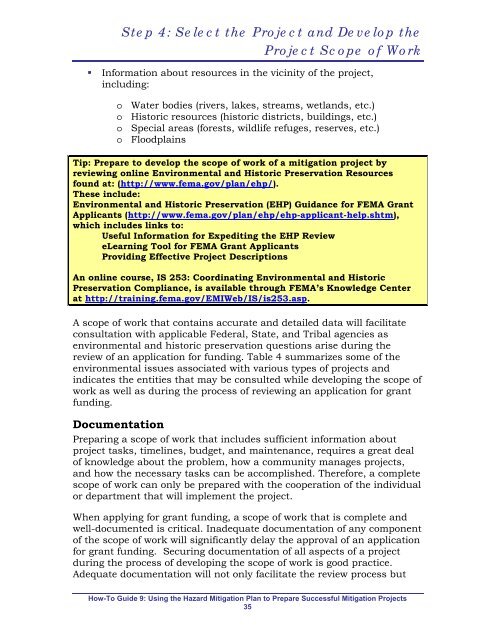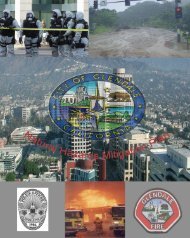Using the Hazard Mitigation Plan to Prepare Successful Mitigation ...
Using the Hazard Mitigation Plan to Prepare Successful Mitigation ...
Using the Hazard Mitigation Plan to Prepare Successful Mitigation ...
Create successful ePaper yourself
Turn your PDF publications into a flip-book with our unique Google optimized e-Paper software.
Step 4: Select <strong>the</strong> Project and Develop <strong>the</strong><br />
Project Scope of Work<br />
• Information about resources in <strong>the</strong> vicinity of <strong>the</strong> project,<br />
including:<br />
o Water bodies (rivers, lakes, streams, wetlands, etc.)<br />
o His<strong>to</strong>ric resources (his<strong>to</strong>ric districts, buildings, etc.)<br />
o Special areas (forests, wildlife refuges, reserves, etc.)<br />
o Floodplains<br />
Tip: <strong>Prepare</strong> <strong>to</strong> develop <strong>the</strong> scope of work of a mitigation project by<br />
reviewing online Environmental and His<strong>to</strong>ric Preservation Resources<br />
found at: (http://www.fema.gov/plan/ehp/).<br />
These include:<br />
Environmental and His<strong>to</strong>ric Preservation (EHP) Guidance for FEMA Grant<br />
Applicants (http://www.fema.gov/plan/ehp/ehp-applicant-help.shtm),<br />
which includes links <strong>to</strong>:<br />
Useful Information for Expediting <strong>the</strong> EHP Review<br />
eLearning Tool for FEMA Grant Applicants<br />
Providing Effective Project Descriptions<br />
An online course, IS 253: Coordinating Environmental and His<strong>to</strong>ric<br />
Preservation Compliance, is available through FEMA’s Knowledge Center<br />
at http://training.fema.gov/EMIWeb/IS/is253.asp.<br />
A scope of work that contains accurate and detailed data will facilitate<br />
consultation with applicable Federal, State, and Tribal agencies as<br />
environmental and his<strong>to</strong>ric preservation questions arise during <strong>the</strong><br />
review of an application for funding. Table 4 summarizes some of <strong>the</strong><br />
environmental issues associated with various types of projects and<br />
indicates <strong>the</strong> entities that may be consulted while developing <strong>the</strong> scope of<br />
work as well as during <strong>the</strong> process of reviewing an application for grant<br />
funding.<br />
Documentation<br />
Preparing a scope of work that includes sufficient information about<br />
project tasks, timelines, budget, and maintenance, requires a great deal<br />
of knowledge about <strong>the</strong> problem, how a community manages projects,<br />
and how <strong>the</strong> necessary tasks can be accomplished. Therefore, a complete<br />
scope of work can only be prepared with <strong>the</strong> cooperation of <strong>the</strong> individual<br />
or department that will implement <strong>the</strong> project.<br />
When applying for grant funding, a scope of work that is complete and<br />
well-documented is critical. Inadequate documentation of any component<br />
of <strong>the</strong> scope of work will significantly delay <strong>the</strong> approval of an application<br />
for grant funding. Securing documentation of all aspects of a project<br />
during <strong>the</strong> process of developing <strong>the</strong> scope of work is good practice.<br />
Adequate documentation will not only facilitate <strong>the</strong> review process but<br />
How-To Guide 9: <strong>Using</strong> <strong>the</strong> <strong>Hazard</strong> <strong>Mitigation</strong> <strong>Plan</strong> <strong>to</strong> <strong>Prepare</strong> <strong>Successful</strong> <strong>Mitigation</strong> Projects<br />
35

















